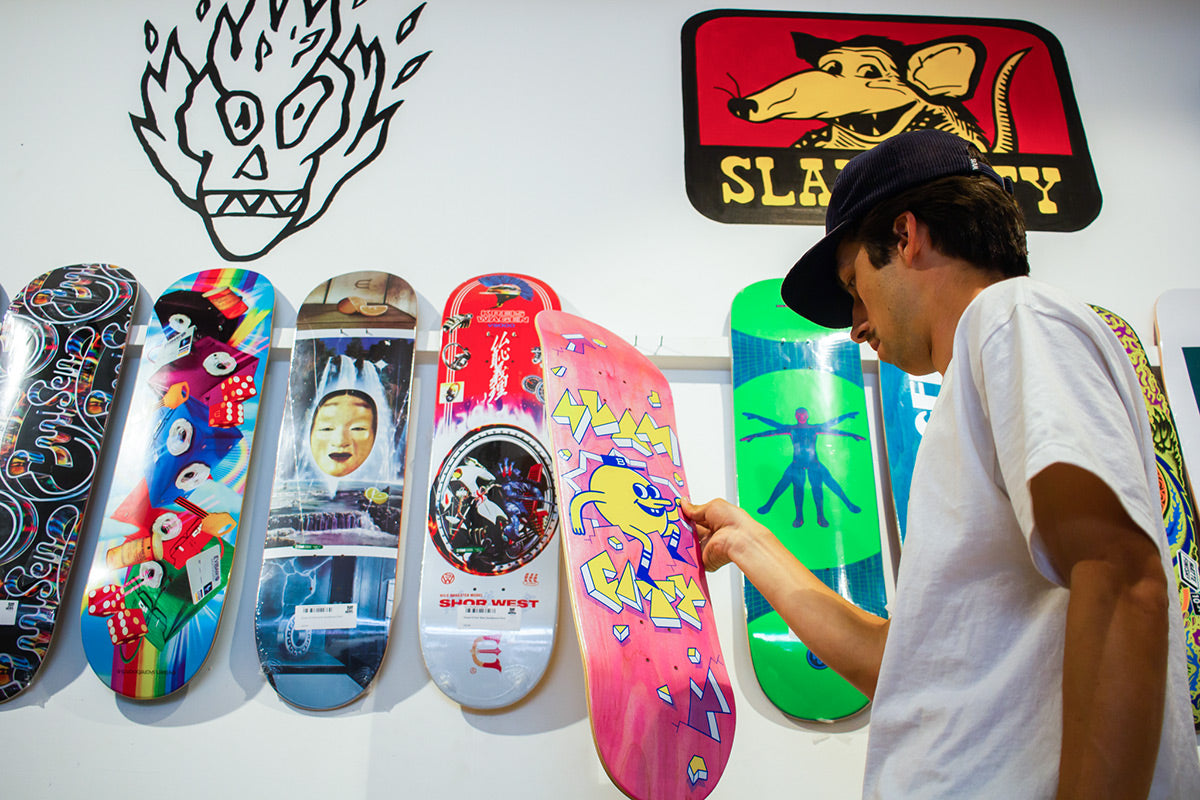We all remember picking out our first deck and assembling a skateboard from scratch. It’s an important and formative moment for any skateboarder. If you are reading this then you are obviously already thinking about it. It’s worth evaluating if this is the right move for you. If you already have some skateboarding experience you will have gathered some ideas about your preferences. This guide will give you some more info about different sizes and advice about making the right choice when buying your first skateboard deck. It also explains what the different measurements used are exactly and any terminology you may not be familiar with.

Although we often recommend ready made completes for first time skateboarders there is no reason why your first complete skateboard can’t be built to your specifics. We can easily put together a custom built complete. Or perhaps you are upgrading your first complete by purchasing a new deck for your existing trucks and wheels? Whatever your plan, if you want to buy your first board we have you covered with over 600 skateboard decks in stock. What follows is all the information you need to make an informed choice.







Although we often recommend ready made completes for first time skateboarders there is no reason why your first complete skateboard can’t be built to your specifics. We can easily put together a custom built complete. Or perhaps you are upgrading your first complete by purchasing a new deck for your existing trucks and wheels? Whatever your plan, if you want to buy your first board we have you covered with over 600 skateboard decks in stock. What follows is all the information you need to make an informed choice.

How to pick the right skateboard deck for you
Buying a skateboard is a great experience. It’s one that we are always happy to talk you through in one of our shops. The advantage of visiting us in person is that you can hold and stand on the decks to get a real feel for them. If you can’t physically do that then of course our range online reflects what is available in our shops and each board has it’s specific sizing in the product description. We will talk you through the different sizes and who and what they are suited to in this guide. This should definitely influence your decision. However there is an element of Harry Potter visiting Ollivanders wand shop in Diagon Alley to the whole process. That board may just choose you! Graphics play an important role so make sure you find one which you really like. You’re going to be looking at that thing a lot, and if skateboarding becomes a lifelong passion for you like it has for all of us you’ll be reminiscing about it when you’re old and grey. It’s a great idea to look through all of the boards we have in stock and make a short list of the ones you like aesthetically. Some of them are going to jump out at you. Afterwards by reading a little more about sizing you can figure out which one will be the best.
What size skateboard deck should I choose?
One of the main differences between any of the decks that we sell is it’s width. Boards range from 7.5” wide to above 8.5” wide. Although we are only talking about an inch here, the width of the board can make a world of difference to someone learning how to do tricks. Of course, like everything in skateboarding personal preference plays a huge part and there are no strict rules but this guide should point you in the right direction. Learning on a board which corresponds to your shoe size will make the initial learning stages easier and help you gain control. After that you will be in a good space to start experimenting with what size board you ride. The visual guide above shows you the kind of shoe to board ratio you want to be aiming for ideally. The smaller your feet, the narrower the board width you want to be shopping for. We often recommend young kids who have much smaller feet entertain one of our complete skateboards tailored to their size which are available even narrower than 7.5”. Read more about the different widths available to figure out which one works for you…
7.5” - 8” Wide
This size range is the narrower end of the spectrum. The smallest board any company that we stock makes is 7.5” wide. 7.5” to 8” wide is a medium size which is ideal for kids and teenagers through to adults learning to skate and mastering technical tricks. The thought behind this is that the less board you have under your feet the easier it is to flip and manipulate. Your deck will be lighter and flip faster. If you aren’t very tall and have smaller feet you will have more control. As a rule If your feet fit over the board from rail to rail you are in a good place. If they are flapping over the edges you will want to consider a wider board. Also if you are young and have very small feet having too much board around your feet may hinder learning certain tricks. Some of the complete skateboards we sell come in even smaller widths made specifically for kids starting out, these would be considered a youth size and will help with that foot to board ratio. You can find those complete skateboards here.8.1” - 8.4” Wide
If you are a teenager or adult buying your first deck then this size bracket may be best suited to you. We sell a huge amount of boards in these sizes, they are a popular choice for a large portion of the skateboarding community. If you are a size UK 8 shoe or bigger you will be in the right ballpark for having good control over the board beneath you whether you are learning street tricks, skating parks or bowls or just getting used to rolling around. People who have been skating for years have a specific size they favour and choose time after time. If this is your first deck you have years ahead to figure out the exact size that best works for you so don’t stress too hard over 1/8th of an inch. You’re in a way better place to learn flip tricks than you would have been in the 80’s.8.5” Wide and above
If you are a bit bigger then a board 8.5” and above could be the best first deck for you. It would be an ideal size for learning to push and navigate the local park and will feel super stable. Skaters who have spent years mastering their craft have no problem flipping boards this size around and find the stability they offer on bigger tricks preferable. Bear in mind that this won’t be the case if you haven’t done a kickflip yet, a bigger deck will require more effort to flip and ollie on so you may consider going down a few sizes once you’ve mastered the basics on a board this size.
Board length and wheelbase
You will notice that as well as the width, each deck we sell also contains information about board length and wheelbase in the product description. The illustration above shows exactly what these measurements pertain to. The tail is the back end of the deck behind the truck holes and the nose is the front end beyond the truck holes. The length is the measurement from the tip of the tail to the tip of the nose. Wheelbase is the measurement between the front and back bolts closest to the middle of the board. These nuances are specifics that seasoned skateboarders may agonise over but when choosing your first deck it’s not a huge issue. Narrower skateboard decks generally have a 31” length and a 14” wheelbase. As board width increases so does the length and wheelbase. As previously stated the most important measurement when picking out your deck is the right width for you.
Concave
In the 80s many skateboard decks were completely flat before manufacturers responded to the demands of their professionals who wanted a more concaved board for enhanced control. Today you will find all of the boards we sell are concaved. Concave is the longitudinal curvature of the deck, the top of the deck is flat and the mold it is pressed in creates the tapered shape of the sides. Different board companies favour different degrees of concave or offer a selection. All of our boards will list the level of concave on each board. The graphic above illustrates what 1. Low Concave. 2. Medium Concave and 3. High Concave look like. How concaved you like your board to be will be another preference you develop as you progress. One way to figure out what feels best to you before you buy a skateboard is to visit one of our shops and actually stand on some boards before purchasing. You will be able to figure out what feels too flat, too steep, or just right. Boards with a low concave are flat, this makes them more stable but offers less control. Medium concave will give you added flick you need when mastering kickflips and beyond. Concave is definitely your friend when you are learning flip tricks and provides added foot hold for grinds and slides. High concave means much steeper sides and is often favoured by transition skaters who crave that extra bit of edge for added control. Boards with a steeper concave also have increased rigidity so street skaters looking for added pop may opt for a deeper concave too. As a rule we recommend opting for a medium concave because it offers you additional flick when you need it and doesn’t get in the way of quick foot positioning. We are sure your skateboarding journey will involve many different board shapes and each one has it’s own pros and cons. Standing on a few different boards to weigh up the feel of their concave is definitely a good way to determine what feels most natural to you.
